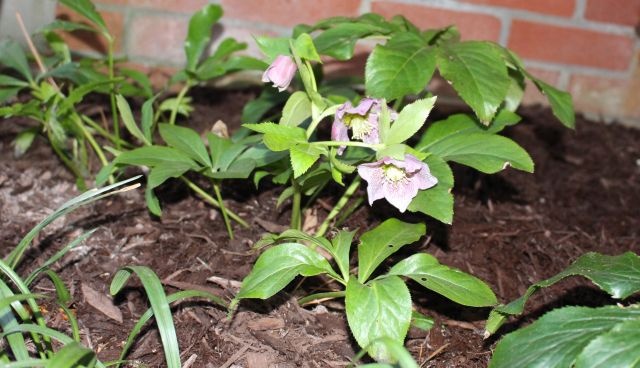Hellebores: AKA Lenten Roses

Most hellebores, more commonly known as Lenten Roses, are starting to come into their own this time of year. These evergreen early bloomers are the darlings of late winter/early spring gardens. They are now beginning to appear in the local garden centers so, if you don’t already own some, now is your chance to claim one. When purchasing hellebores, plan to buy ones that are in bloom if you are seeking a particular style or color. We all know how unreliable informational tags can be when it comes to color.
The popular name Lenten Rose perhaps originated because the plants start to bloom during the religious period of Lent. They are, however, definitely not a member of the rose family. Growing but a foot or so tall, the Lenten Rose produces a wide variety of long lasting flowers with colors ranging from white to green to dark red and hundreds of shades in between.
While the older varieties predominately have heads that nod downward, breeders have been working to develop more types that face upward. Depending on the variety, flowers can be single or in clusters. The plants can be expected to bloom over a period of several months. Some flowers are reported to be fragrant and some are definitely not. If you think you might want to use hellebores as cut flowers, we suggest that you sniff before you buy.
The leaves of the Lenten Rose can be as varied as its flowers, sometimes growing at the ends of longish stems and sometimes right from the ground. Foliage can be chartreuse or very, very dark green and many shades in between. With five leathery “fingers”, the deeply lobed leaves are decorative in their own right. This time of year, as you work on your winter clean-up, remove the tattered and torn leaves from last year’s growth, being careful not to cut new foliage or flowers. As new growth becomes visible, it’s a good idea to sprinkle lightly with a balanced plant food.
Hellebores thrive in soil with high organic content and regular moisture in a woodsy setting. This is the atmosphere in which they are more likely to self-sow. Because of their indiscriminate cross-breeding habits, none of the new plants are likely to look like any of the parent plants. You probably won’t see growth of this spring’s seeds until fall or perhaps even next spring. At that time, you will find them in the form of small plants growing close to the parent plant. When you move the babies out, be sure to provide optimal growing conditions until they are well established. At that time, you will find they are quite hardy and can survive in a wide variety of soil, moisture and sun conditions.
If you garden with kids (borrowed or your own), keep in mind that all parts of the plants are poisonous if ingested. Now, while most of us have kids who do not graze indiscriminately on unknown vegetation, there is always that one kid we all have to look out for!
Gardening Grannies, a group of avid and Master Gardeners, live, love and garden on the Delmarva Peninsula


